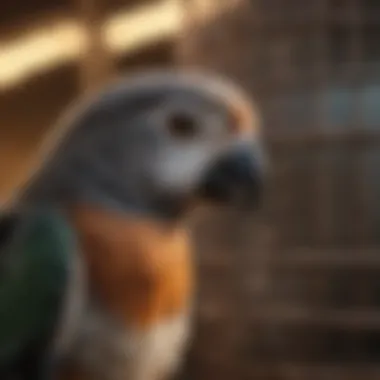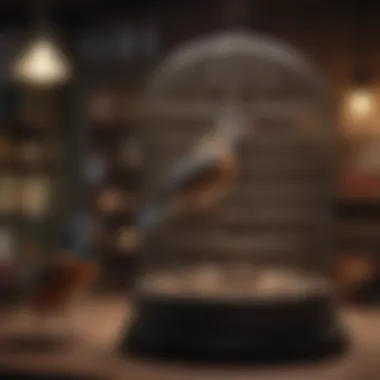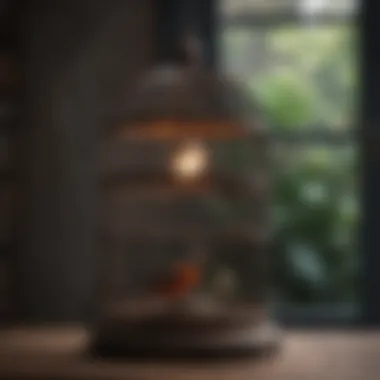Finding Affordable Second Hand Bird Cages Near You


Intro
Acquiring a second-hand bird cage is often a journey filled with considerations and reflections. For many enthusiasts, the task goes beyond simple purchasing; it can reflect values of sustainability and a commitment to the welfare of their feathered friends. This guide will navigate you through the process of finding second-hand bird cages, focusing on crucial elements such as the benefits of these investments, the selection process, and ethical considerations. Understanding these factors is essential for making informed decisions and ensuring a healthy and vibrant environment for pet birds.
Care Tips
Taking care of birds begins with understanding their environment. When you choose a second-hand cage, the first aspect to consider is how to provide a thriving habitat for your avian companion. Below are some important care considerations for your newly acquired second-hand cage.
Daily Care Routines
Establishing a daily routine helps ensure your birds remain healthy. Daily checks should include verifying the cleanliness of the cage and providing fresh food and water. Spend some time observing your birds to check for signs of distress or illness. A consistent routine helps birds feel secure in their environment.
Cage Setup and Maintenance
Set up the cage properly by allowing ample space for movement and exercise. Ensure there are perches, toys, and food containers accessible. Maintenance is also important; you should examine the cage for wear and potential hazards. Even a well-maintained second-hand cage must align with best practices in safety and comfort.
Hygiene and Cleaning Practices
Cleanliness is critically important when slecting a second-hand cage. Often, cages can house residues of old food and waste. Create a cleaning schedule, ideally on a weekly basis, using safe and appropriate non-toxic cleaning products. Remove all items from the cage, scrub surfaces, and rinse well. This prevents health risks for your birds by reducing pathogens.
Seasonal Care Adjustments
Different seasons may require changes in care. In winter, heating sources like heat lamps may be necessary to maintain a comfortable environment. In summer, ensure cooling is available through adequate ventilation and possibly lower temperatures. Always stay attuned to your birds’ needs as weather conditions shift.
Wellness and Health
Staying vigilant about your birds’ health is intertwined with their well-being. Regular health checkups and knowledge of potential symptoms can aid in preventive care. By ensuring a routine of examinations, you can spot possible issues early.
Routine Health Checkups
Birds should have routine veterinary visits, typically once a year. An established vet familiar with avian creatures can provide routine checkups, which help track your bird’s health over time. Maintain a documented record of health updates for consult purposes.
Identifying Symptoms of Illness
Knowledge about the signs of common avian diseases is vital. Monitor for changes in behavior, such as lethargy, feather plucking, and changes in eating habits.
Learn to recognize these symptoms:
- Fluffed feathers
- Nasal Discharge
- Change in droppings
Preventative Care and Vaccinations
Understanding which vaccinations are crucial for your bird types is equally important. Research or consult your veterinarian about their recommendations for your specific pet type.
Mental and Emotional Well-being
Birds are sensitive creatures and mental health is just as important as physical health. Keep cages engaging and provide social interaction opportunities to promote emotional prosperity. Create habits and environments conducive to mental stimulation with toys and daily interaction from owners.
Enriching Activities
Ensuring a stimulating environment is necessary for bird happiness. Boredom can result in behavioral issues, so focus on engaging your birds with a variety of enriching activities.


Toys and Playtime Ideas
Investing in a variety of toys assists in physical and mental stimulation. Rotate toys regularly to maintain interest, introducing new options such as foraging toys. Ownership of quality toys enhances a bird’s ability to play and interact.
Training and Tricks
Train your birds through positive reinforcement. Use treats or praise as rewards for desired behavior. Simple commands, like
Understanding Second Hand Bird Cages
Second hand bird cages represent both a viable choice and an environmental consideration for pet bird owners. Particularly for those who prioritize getting the best for their avian companions, understanding this topic reveals various advantages and practical considerations. From financial easements to sustainable practices, the benefits are numerous. Let's dive deeper into the definition and importance of second hand bird cages, as well as their advantages in this comprehensive guide.
Definition and Importance
Second hand bird cages refer to previously owned cages that are available for resale. These cages can vary greatly in size, style, and condition. Understanding what constitutes second hand includes recognizing that these cages may have been utilized for various bird species prior to reselling. The importance lies not only in the cost-effective option they present but also in the opportunity to give these items a new lease on life, thus contributing to waste reduction in consumerism.
Furthermore, selecting a quality second hand cage can ultimately provide a safe environment for pet birds. Owners should prioritize knowledge of previous usage and maintenance to assess if the cage is suitable for their intended pet.
Advantages of Buying Second Hand
Acquiring second hand bird cages has distinct benefits:
- Cost Considerations: Second hand prices are generally lower than new counterparts. This can allow a prospective bird owner to invest more in accessories like toys and enrichment items.
- Sustainability: Purchasing existing products minimizes the production demand for new items, contributing positively to environmental efforts.
- Unique Styles: Often, second hand cages come with particular charm or historical significance, unavailable in mass-produced versions.
- Potential for Rare Finds: Explorations of flea markets or second hand stores may lead to discovering cages made of materials or designs particularly conducive to certain bird species, increasing their well-being.
- Absence of Long Wait Times: When finding a suitable second hand option locally, buyers can often take home their purchase immediately, rather than waiting for delivery associated with online shopping or new items.
Buying second hand is not solely about savings but it holds a meaningful place in promoting responsible consumption. Engaging in smarter buying allows bird enthusiasts to support economic cycles while caring for their feathered charges.
What to Consider When Purchasing Second Hand Bird Cages
When seeking second hand bird cages, making informed decisions is crucial. Factors such as material, size, and condition directly affect the well-being of the avian inhabitants. Understanding these elements ensures the safety and comfort of your bird, contributing to its overall health. Let's delve into key considerations that will help in selecting the right cage for your feathered friend.
Material Considerations
Metal Types
Metal cages are commonly found and favored for their durability. Zinc-aluminium and stainless steel are typical choices. Often, these materials withstand wear, making them long-lasting options. Stainless steel, in particular, resists rust, which is essential for maintaining hygiene. However, improper finishes may become harmful, so one should verify if the material has been treated safely.
Plastic Materials
Cages constructed from plastic offer a lighter alternative. They are easier to clean, which is important for maintaining health standards. One big advantage is that they can be designed in various styles attracting pet owners. Nonetheless, cheaper plastics might not hold up against aggressive chewers, and subsequent damage can lead to unsafe conditions. Knowing quality and resilience is essential when considering plastic cages.
Wood Options
Wooden cages present an aesthetic appeal for many owners. They mimic natural habitats, which can be comforting for the bird. Certain woods are pleasing to the eye; however, consider that staining and sealing are vital to durability. Unfinished wood can become porous, absorbing waste, which may become breeding grounds for bacteria. Researching associated treatments for woods is necessary for a second-hand cage.
Size and Dimensions
Space Requirements for Different Bird Species
Bird breeds have unique space requirements that reflect their comfort and health. Larger species such as macaws need more open space, while smaller species can manage with a cozier setting. Knowing the size gives basic guidelines on what to look for in a second hand cage.
Cage Height and Width
Height is often overlooked, but a greater vertical space ensures birds utilize different levels. Birds like to fly up and down, not just side to side. Similarly, width matters, providing room for play and movement. Each species has specific preferences, and thus measurements should align with those needs for optimal health.


Condition of the Cage
Signs of Wear and Tear
With second hand items, specific indicators signal overall condition. Torn wires and fading surfaces are red flags. These reflect how well a cage has been cared for and whether it can be used safely for another bird. Familiarizing with common signs of general wear before purchasing is critical.
Rust and Corrosion Indicators
Rust can present severe threats, especially to metal cages. Examine for any visible oxidation. Corroded areas are not only damaging for the cage but also harmful for birds if ingested. Thus, in potential purchases, identifying these hazards will contribute to safer living environments for pets.
Where to Find Second Hand Bird Cages Near You
Finding second hand bird cages can present both a challenge and an opportunity for bird enthusiasts. Having access to suitable options, especially locally, is vital for several reasons. First, it enables immediate examination of the cage’s condition. Since birds require specific environments, understanding the dimensions and materials used in cages before buying is essential. Individuals may also save a substantial amount of money compared to buying new cages.
Identifying various sources simplifies the search process in many respects. Below are several effective methods for locating second-hand cages within your vicinity. Each option offers unique advantages, catering to diverse preferences and needs.
Local Classified Websites
Local classified websites such as Craigslist or Gumtree are excellent platforms to consider for finding second-hand bird cages. These sites usually provide listings from sellers in your area. The advantage rests in the immediacy and localized nature of the ads. Sellers often post dimensions, photos, and prices. Further, since they deal directly with purchasers and negotiate prices, buyers may achieve substantial savings.
- Explore various listings; - Contact sellers directly for inquiries; - Arrange pickups to see the cage firsthand;
While convenience is appealing, understanding risks associated with online transactions is essential. Always meet in public places if possible, and inspect the cage for any wear or damage.
Social Media Marketplace Groups
Platforms like Facebook offer marketplace features for buying and selling. Joining local social media groups dedicated to pets or birds allows members to advertise cages they wish to sell. These groups often feature people who understand the specific needs of bird owners.
By using social media groups, one can:
- Get situated within a community;
- Access deals from bird-lovers directly;
- Engage with sellers to ask questions regarding usage and history of cages.
The visual aspect of social media supports quick evaluation through shared photos, also providing community feedback on experience with the seller.
Second Hand Shops and Thrift Stores
Lastly, second hand shops and thrift stores present outstanding options. These stores often rotate inventory frequently, occasionally receiving bird cages in various conditions. Exploring different locations allows discovery of unique and possibly high-quality structures.
While these settings provide a treasure-hunt feel, one can:
- Gain within budget alternatives;
- Experience personal interactions that stimulate local commerce;
- Advocate for recycling and reusing which promotes sustainable practices.
However, preparation should be made to take necessary measurements before labeling any cage as suitable. Thorough examination of potential purchases ensures compatibility for the intended bird type.
In summary, understanding where to find second-hand bird cages relies on diverse sources and personal safety during any transaction, enabling owners to make informed choices.
Evaluating Potential Purchases
Evaluating potential purchases is critical when considering second hand bird cages. Buyers must ensure that they find cages that not only fit the needs of their birds but are also safe and reliable. This part of the purchasing process involves asking the right questions and verifying the seller's reliability. Focusing on details will lead to informed decisions, preserving the welfare of the birds as a top priority.
Questions to Ask Sellers
Engaging in a conversation with sellers is essential. While inspecting a second hand cage, these questions can clarify crucial details:


- What is the history of the cage? Understanding how long the cage has been used and what type of birds resided in it influences your decision.
- Has the cage endured any repairs? If so, which parts were repaired and how effective were these repairs? This sheds light on the cage's longevity.
- Are there any behavioral changes in the birds after using this cage? Knowing how previous birds interacted with the cage can reflect its suitability for new residents.
- What materials are it made of? Confirm if the cage materials are safe for your specific bird species. Some metals can be harmful if birds chew them.
- Why are you selling the cage? The reasons for selling might imply critical details about the product’s usability.
Transporting and Setting Up a Second Hand Cage
When you have finally made the decision to purchase a second hand bird cage, the next phase involves transporting that cage safely to your home and setting it up correctly. This process is not just about getting the cage from Point A to Point B; it also entails ensuring the cage remains safe and functional for your feathered friends. Proper handling during transport safeguards against potential damage.
Best Practices for Transport
Transporting a second-hand bird cage needs careful planning. Here are important steps:
- Disassemble when possible: If the cage is large or has multiple components, taking it apart will make transport easier. Make sure you keep all parts accounted for, especially screws or small pieces.
- Use protective blankets: Wrapping the cage in padded blankets offers extra protection against bumps and scrapes during transit.
- Secure it in place: Whether you are using a vehicle or a cart, ensure the cage is stationed securely. It should not move around in transit.
Focusing on the method you choose when loading will protect both the cage's structural integrity and its aesthetic appearance. Clear planning can lead to a successful experience without complications during transport.
Sanitizing the Cage
After arriving home, cleaning is crucial. Ensuring the cage is sanitized creates a safe living space for your birds. This action reduces any chance of transferring bacteria or diseases from previous birds. A thorough cleaning approach should cover all nooks and crannies.
Recommended Cleaning Solutions
Among cleaning solutions, white vinegar works well. It is a natural disinfectant that effectively breaks down grime and kills many types of bacteria. This makes it a beneficial choice for preparing a second hand bird cage. Another option is using specialized bird-friendly cleaners that provide antiseptic benefits while ensuring safety for your pets. They often come in spray form, making them convenient.
A feature of vinegar is that it's non-toxic and does not impart any harmful chemicals into the environment. However, always rinse thoroughly afterward to eliminate any residue.
Drying and Prepping
Once the cage has been cleaned, drying it properly is essential. Incomplete drying can promote mold growth and negatively affect air quality within the cage. Thus, make use of cloths to dry each section before reassembling. The key characteristic of proper drying methods includes ensuring not too much moisture remains before introducing your bird to its new home.
A unique benefit of allowing the cage to air dry before assembly is that it minimizes any lingering odors from cleaning substances. Make sure the cage is completely dry. This will improve the environment created for your bird while emphasizing diligence in safety and sanitation practices.
Placement Considerations in the Home
Choosing the appropriate location for your second hand bird cage cannot be overlooked. Opting for a suitable spot is critical for the comfort and well-being of your bird. Pointing factors to reflect on include:
- Natural Light: Birds thrive in sunlight but should not be placed in direct sunlight all day to prevent overheating.
- Noise: Place the cage in a quieter area to alleviate stress for your bird.
- Humidity: Avoid bathrooms or damp places to maintain proper environmental conditions.
- Olympic Control: Ensure that the cage is nowhere near heat sources, such as radiators or open flames.
Incorporating these maneuvers into your setup strategy can radiantely improve the lasting partnership between you and your pet.
Remember, the better the environment you provide, the happier your bird is likely to be.
Ending and Final Thoughts
In light of everything discussed, it is clear that purchasing a second-hand bird cage requires careful thought. This guide has laid out various areas of consideration that prospective buyers should evaluate. Making a knowledgeable decision not only affects the bird’s living environment but also heavily impacts the overall wellbeing of avian companions. The information presented makes the process more transparent. It outlines practical steps for selecting cages, emphasizes safety and cleanliness, and urges responsible actions for both buyers and birds.
Making Informed Choices
Acquiring a second-hand bird cage can be an economic and environmentally friendly option for many. First, understanding the specific needs of your bird species avidly contributes to making appropriate decisions. Before you engage in any transaction, consider asking precise questions. It is vital to acquire details such as the cage's history, any previous repairs done, and its general usability based on the current condition.
Thinking about parameters like size, convenience, and maintenance can help you gauge if the cage fits well in your living situation. Furthermore, ensuring that it aligns well with holiestic training and engagement for your birds will make your buying decision more reputable. This can include researching proper dimensions for the species you wish to accommodate. Not all cages cater well to every bird, and information is an essential tool.
Consider also the ropes and privacy features intended for birds. Benefits can extend over providing well-balanced socialization and reducing noise levels createdby your feathered friends. If properly fulfilled, such an approach nurtures positive interactions.
Encouraging Responsible Bird Care
Evoking responsible bird care starts before the purchasing phase. Educating others about sustainable practices—like opting for second-hand cages—reflects commitment to animal welfare. Once the decision-maker, focusing on the aspects of a bird’s structure, dietary needs and psychological behaviors become crucial elements after acquisition.
Remember, each bird carries its unique personality. Therefore, making responsible choices about their habitat and accessories should carry on among peers and fellow enthusiasts. Simple actions can initiate conversations that compel others to consider and prioritize ethical considerations, setting a better example to the community. Instilling knowledge among breeders, pet owners, and enthusiasts fosters a more aware society, consequently benefitting birds in shared ecosystems.
You are not simply fulfilling a need; you are acting with a sense of responsibility to care for their sanctuary. Making second-hand purchases offers the solace of doing well for the planet while enhancing your avian companions' experience. As such, ensure your carpentry and planning genuinely represent the best interest of your feathery roommates.















